Wikipedia
Minecraft Wiki
2015-04-05-13:10
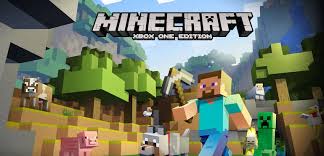
Read the full article here: http://en.wikipedia.org/wiki/Minecraft
Minecraft is a sandbox independent video game originally created by Swedish programmer Markus "Notch" Persson and later developed and published by the Swedish company Mojang. The creative and building aspects of Minecraft allow players to build constructions out of textured cubes in a 3D procedurally generated world. Other activities in the game include exploration, gathering resources, crafting, and combat. Multiple gameplay modes are available, including survival modes where the player must acquire resources to build the world and maintain health, acreative mode where players have unlimited resources to build with and the ability to fly, and an adventure mode where players play custom maps created by other players.
The alpha version was publicly released for PC on May 17, 2009, and after gradual updates, the full version was released on November 18, 2011. A version for Android was released a month earlier on October 7, and an iOS version was released on November 17, 2011. The game was released on the Xbox 360 as an Xbox Live Arcade game on May 9, 2012; on the PlayStation 3on December 17, 2013; on the PlayStation 4 on September 4, 2014; on the Xbox One the next day; and on the PlayStation Vita on October 14, 2014. On December 10, 2014, a Windows Phone version was released.[14] All versions of Minecraft receive periodic updates, with the console editions being co-developed by 4J Studios.
Minecraft received five awards during the 2011 Game Developers Conference. Of the Game Developers Choice Awards, it won the Innovation Award, Best Downloadable Game Award, and Best Debut Game Award; from the Independent Games Festival, it won the Audience Award and the Seumas McNally Grand Prize. In 2012, Minecraft was awarded a Golden Joystick Awardin the category Best Downloadable Game. As of October 2014, over 60 million copies had been sold, including 12 million on the Xbox 360 and 18 million on PC, making it the best-selling PC game to date. On September 15, 2014, Microsoft announced a deal to buy Mojang, along with the ownership of the Minecraft intellectual property. It was worth $2.5 billion and was completed on November 6, 2014.[15][16][17]
[..clip..]
Minecraft is an open world game that has no specific goals for the player to accomplish, allowing players a large amount of freedom in choosing how to play the game.[18] However, there is an achievement system.[19] Gameplay by default is first person, but players have the option to play in third person mode.[20] The core gameplay revolves around breaking and placing blocks. The game world is composed of rough 3D objects—mainly cubes—arranged in a fixed grid pattern and representing different materials, such as dirt, stone, various ores, water, and tree trunks. While players can move freely across the world, objects can only be placed at fixed locations on the grid. Players can gather these material blocks and place them elsewhere, thus allowing for various constructions.[21]
[..clip..]
Commercial
On January 12, 2011, Minecraft passed 1 million purchases, less than a month after entering its beta phase.[110][111] At the same time, the game had no publisher backing and has never been commercially advertised except through word of mouth,[112] and various unpaid references in popular media such as the Penny Arcade webcomic.[113] By April 2011, Persson estimated that Minecraft had made €23 million (US$33 million) in revenue, with 800,000 sales of the alpha version of the game, and over 1 million sales of the beta version.[114] In November 2011, prior to the game's full release, Minecraft beta surpassed 16 million registered users and 4 million purchases.[115] By March 2012, Minecraft had become the 6th best-selling PC game of all time.[116] As of October 10, 2014, the game has sold 17 million copies on PC, becoming the best-selling PC game of all time.[117] As of October 10, 2014, the game has sold approximately 60 million copies across all platforms, making it one of the best-selling video games of all time.[117][118] On February 25, 2014, the game reached 100 million registered users.[119]
AlienGamer is a donor to Wikipedia Foundation. Are you?
If not, go HERE and put down a donation?
TES3: Morrowind Wiki
2015-03-08-16:10
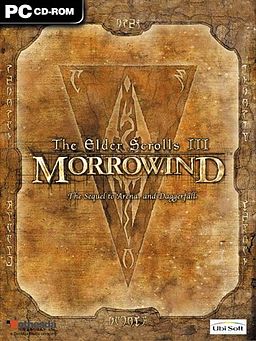
Read the full Article here: http://en.wikipedia.org/wiki/The_Elder_Scrolls_III:_Morrowind
The Elder Scrolls III: Morrowind is an open world fantasy action role-playing video game developed by Bethesda Game Studios, and published by Bethesda Softworks and Ubisoft. It is the third installment in The Elder Scrolls series of games, following The Elder Scrolls II: Daggerfall, and preceding The Elder Scrolls IV: Oblivion. It was released in North America in 2002 for Microsoft Windows and the Xbox. Well-received publicly and critically, with over four million sales[3] and more than 60 awards (including Game of the Year),[4] the game spawned two expansion packs for the PC: Tribunal and Bloodmoon. Both were eventually repackaged into a full set containing all three, Morrowind: Game of the Year Edition, which shipped on October 30, 2003, for both PC and Xbox.[5]
The main story takes place on Vvardenfell, an island in the Dunmer province of Morrowind, which lies in the empire of Tamriel and is far from the more civilized lands to the west and south that typified Daggerfall and Arena. The central quests concern the deity Dagoth Ur, housed within the volcanic Red Mountain, who seeks to gain power and break Morrowind free from Imperialreign.[6][7][8] Morrowind was designed with an open-ended free-form style of gameplay in mind, with less of an emphasis on the game's main plot than its predecessors. This choice received mixed reviews in the gaming press, though such feelings were tempered by reviewers' appreciation of Morrowind ' s expansive and detailed game world.
[..clip..]
Free-form design[edit]
Morrowind, following the tradition established by its predecessors in The Elder Scrolls series,[22] attempts to establish a completely free-form world, with little constricting boundaries on the player's actions. From the beginning of the game, players are put in a world where they are left to roam, steal, quest and explore, without necessarily following the main quest.[23] Lead Designer Ken Rolston, asked prior to Morrowind ' s release what he thought were the "core, untouchable design elements" of the Elder Scrolls series which "set them apart from other games", responded immediately: "Free-form experience."[24] In Rolston's view, the game's central plot is a chance to introduce the player to a cross-current of conflicting factions, background themes, and to the characters of the game, rather than the primary focus of the player's experience.[25] "Every TES game has to let you create the kind of character you want, and then do the things you want. We would never have a TES RPG force you to be a certain character or go down a certain path."[24]
To allow for this behavior, Morrowind, in addition to creating an extensive main quest, provides detailed discursive quests for a variety of factions, including various guilds, religious organizations and aristocratic houses, in addition to side-quests found by mere exploration.[26][27] Even the main plot itself may be undertaken in a number of ways. There are, in the words of critic Craig Lindley, "a very specific set of central plot points within this main plot. But the plot points are partially ordered: seven high level tasks must be completed, but their constituent sub-tasks...can be accomplished in any order, and this is repeated for the sub-tasks involved in those sub-tasks." The choices the player makes in their performance of these tasks thus become methods of character interpretation; a set of dramatic tools establishing the player's newly created self-identity.[28]
According to Gamasutra's Matt Barton, some have argued that these changes put Morrowind closer in spirit to the original Dungeons & Dragons tabletop game, where players take a more creative role in their play, and where players are left to decide for themselves the "right" action.[29] This is a view paralleled by Rolston, who has stated that "The goal of every TES game is to create something that resembles a pen and paper RPG on the computer."[24] The sheer number of quest possibilities, combined with what developer Ken Rolston identified as a lack of "narrative urgency", left many critics dissatisfied with the main plot. Ken Rolston later stated that the main quest might have been presented with greater force, in the style of the game's successor, The Elder Scrolls IV: Oblivion, without losing the free-form design of the series, but such concerns were not addressed prior to Morrowind ' s release.[30]
[..clip..]
Reception[edit]
The Elder Scrolls III: Morrowind was well received by critics. It was congratulated most frequently for its breadth of scope, the richness of its visuals, and the freedom it worked into its design. Alongside the compliments, however, came criticism that the game designers had overstretched themselves, leaving glitches in various spots, and made a game too taxing to be run on an average machine, with one reviewer calling it "a resource pig".[59] In a retrospective by 1UP.com, the breadth and open-endedness of Morrowind is suggested to have contributed to the decline of single-player RPGs on home computers by leading customers to MMORPGs, where they could have a similar experience.[80]
In spite of this, reviewers generally felt that the drawbacks of the game were minor in comparison to its strengths. IGN concluded that "Morrowind isn't perfect and its system requirements are huge; but its accomplishments outweigh any reservations."[77] GameSpot's review concluded with a similar summation. "Morrowind does have numerous drawbacks...But they're all generally minor enough that most anyone should be able to look past them...They'll otherwise find that Morrowind fulfills its many ambitious intentions. It's a beautiful-looking, sprawling, and completely open-ended game that allows you to play pretty much however you like”.[60]
[..clip..]
AlienGamer is a donor to Wikipedia Foundation. Are you?
If not, go HERE and put down a donation?
Torchlight Series Wiki
2015-02-23-15:24
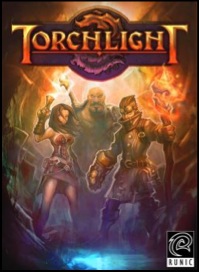
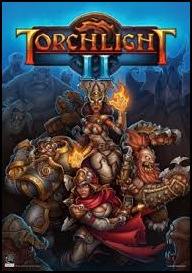
Read the full article HERE!
Torchlight is an action role-playing game developed by Runic Games and published by Perfect World, released for Windows in October 2009.[7] The fantasy-themed game is set in the fictional town of Torchlight and the expansive caverns and dungeons nearby, which adventurers explore to collect valuable loot and battle hordes of monsters.[8] Following the October 2009digital distribution release, a Windows retail box version was released in the U.S. in January 2010 by Encore, Inc,[9] and JoWooD Entertainment published a retail box in Europe in April 2010.[1] A port for OS X was developed by World Domination Industries and released through Steam[10] on May 12, 2010. Runic Games and World Domination Industries developed a port for Xbox Live Arcade which was released on March 9, 2011.[11] A Linux port was released as part of the game's inclusion in the Humble Indie Bundle 6.
Development of the game was led by Travis Baldree, designer of Fate, joined by Max Schaefer and Erich Schaefer (co-designers of Diablo and Diablo II), and the team that worked with Baldree on the original incarnation of Mythos.[12][13] In September 2012, Runic Games released a sequel, Torchlight II, for Windows.[14]
The player controls a lone hero who explores a series of randomized dungeons, fighting large numbers of enemies and collecting equipment, gold, and other loot. The game also features a single town which serves as a hub, to which the player character can periodically return to buy and sell items to NPC vendors and obtain quests.[15] As the protagonist delves into the dungeon, a series of quests are presented which involve battling unique bosses that advance the main storyline. Optionally, the player may take on side quests, random quests or visit branching dungeon areas.[16]The graphics are three dimensional and viewed from an overhead perspective, similar to the isometric perspective used in the original Diablo. On personal computers, the game is controlled using a point-and-click mouse interface and keyboard hotkeys, while the Xbox Live Arcade version uses a controller and has a completely redesigned user interface.[11]
The game generates each level of the dungeon by assembling modular "chunks" of the game environment. Each chunk is designed by hand and may be composed of multiple rooms. They can contain scripted events and interactive objects such as levers that open secret doors or cause bridges to move.[17] This approach to level generation is intended to create dungeons with more purposeful design, instead of environments that simply look like "crossword puzzles that have been extruded upwards."[18]
As in Fate, the player has a permanent pet which fights alongside and can carry and sell loot. The initial pet can be a wolf dog, a lynx or, in the retail version of the game, a ferret;[19] the player can feed fish to their pet to transform it into different creatures.[20]
Also present in the game is a retirement system, in which the player can pass on an heirloom item from an old character to a newly created one, likened to a New Game Plus game mode.[15]
Torchlight features three character classes.[17][20]
- The Destroyer is a wandering warrior skilled in melee combat, although he also has the ability to call upon ancestral spirits to produce magical effects.
- The Alchemist is a spellcaster drawn to the magical power of Ember. He can fire blasts of magic and electricity from his specialized focus glove and can summon imps and steampunk-styled robots.[21]
- The Vanquisher is an elite city guard, sent undercover to investigate the town of Torchlight. She specializes in ranged weapons and can also use traps against her foes.[22][23]
The player develops their character by placing points into class-specific skill trees. Further, there is a separate category of spells that any character can learn from scrolls, regardless of class.[24]
On August 4, 2010 Runic Games announced Torchlight II which will be a continuation of the story, featuring a co-op mode, new player characters, an "overworld" with multiple outdoor areas, and a new user interface.[14][57][58] Although the developers originally estimated a 2011 release, the game was finally released in 2012.[59]
AlienGamer is a donor to Wikipedia Foundation. Are you?
If not, go HERE and put down a donation?
Darwinia Wiki
2015-02-21-15:07
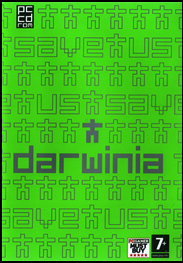
Read the full article HERE!
Darwinia is a 2005 real-time tactics and real-time strategy video game for several platforms. It is the second game developed by Introversion Software, and its setting is within a computer environment that simulates artificial intelligence.
Darwinia was created as a digital theme world for artificially intelligent polygons by Dr Sepulveda. Housed in a massive network of surplus Protologic 68000 machines from the 1980s, Darwinia is a world where the single-poly Darwinians, with their simple, but growing AI, can grow and evolve. Darwinia is also where the world can visit to see them frolicking in their natural, fractal habitat. A Darwinian lives a life working and growing, until the eventual death of the Darwinian, which releases their digital soul to later be reincarnated.
However, the player arrives in the midst of an emergency. Darwinia has been infected by a computer virus, and Sepulveda is in near panic, watching decades of research being corrupted and being used up. Sepulveda enlists the player, a curious hacker who stumbled across Darwinia by accident, to aid him in rescuing the Darwinians and drive off the computer virus. The player is given access to the combat programs, simple tools that originally began as mini-games. These are now the only means of attack against the virus. As the player progresses, it soon becomes clear this is not enough, and that triggers the third aspect of the gameplay, which is evolution.
The first two levels of the video game act as an introduction and allow the player to familiarize themselves with the controls. After that, Dr Sepulveda begins assigning tasks that span several levels to achieve a long-term objective. The first task involves clearing the virus population from and reactivating the Mines and Power Generator to provide resources for the Construction Yard. Once done, the Yard begins producing armored units, allowing the player to move on. The next task involves the reincarnation of Darwinians: the Soul Repository in the center of Darwinia collects the floating souls, and sends them down to the Receiver, where the Darwinians gather them and send them to the Pattern Buffer to be reprogrammed with the main Darwinian blueprint code, where they are sent to the Biosphere to be reborn. The player must clear the Viruses from all the facilities and reactivate them.
In the final level of the game, Sepulveda traces the Viral infection back to its source, which is e-mail spam. After Sepulveda had accidentally flashed an image of his face across the skies of Darwinia, The Darwinians had assumed him to be God. They then re-aligned a portal inside Darwinia in an attempt to communicate with God. The Darwinians managed to access Sepulveda's computer, downloading several files and eventually downloading the Spam. The e-mails were infected with a very nasty strain of internet virus which corrupted the Darwinians. The player is tasked to destroying the few remaining e-mails.
Darwinia mixes elements from strategy, action, puzzle, hacker and God games alike, meaning that it does not fall under a specific video game genre.[1]The player has the ability to run several programs through the Task Manager (a reference to the Windows Task Manager),[citation needed] similar to units used in many real time strategy games. Research allows the player to upgrade programs and weapons, which is critical as the enemy develops. Mission Objectives are given at each location/level, as the player and the Darwinians attempt to wipe out the Viruses.
Darwinia features a number of intros randomly selected when launching the game. These contain a number of references that may be obscure to some players, especially those unfamiliar with older European computers. These include:
- Cracktro text scroller: a spoof of the crack intros that were common among pirated computer games, especially on platforms popular in Europe, such as the Amiga and Commodore 64. The text humorously references both coding for 38 hours straight and finishing the intro in 12 minutes. Allegedly, the release of Darwinia on the Steam platform was delayed for several hours when a Valve employee saw the intro and believed there had been a security breach.[7]
- The Matrix: one intro features green Darwinians dropping from the top of the screen to form a logo, a reference to The Matrix (See Matrix digital rain).
- Real-time Raytracer: another cracktro-style intro featuring a raytraced scene of spinning spheres. This was a popular effect in many old demo scene productions.
- Cannon Fodder: a black screen displaying the text "This game is not in any way endorsed by Sensible Software" while the beginning of the theme from Cannon Fodder plays. The text is a reference to the message that shows at the start of Cannon Fodder, "This game is not in any way endorsed by the Royal British Legion." Some see this as an acknowledgement of Cannon Fodder's influence on Darwinia.
- ZX Spectrum: one of the intros is designed to look like the ZX Spectrum when loading a tape-based game.
- Life: a simulation of the cellular automaton game of Life in which Darwinians live, die and spread in a grid based on just a few basic rules.
- MBTI into: this intro scrolls through the four dichotomies on a Myers-Briggs Type Indicator, listing introversion last as it is the name of the developer.
AlienGamer is a donor to Wikipedia Foundation. Are you?
If not, go HERE and put down a donation?